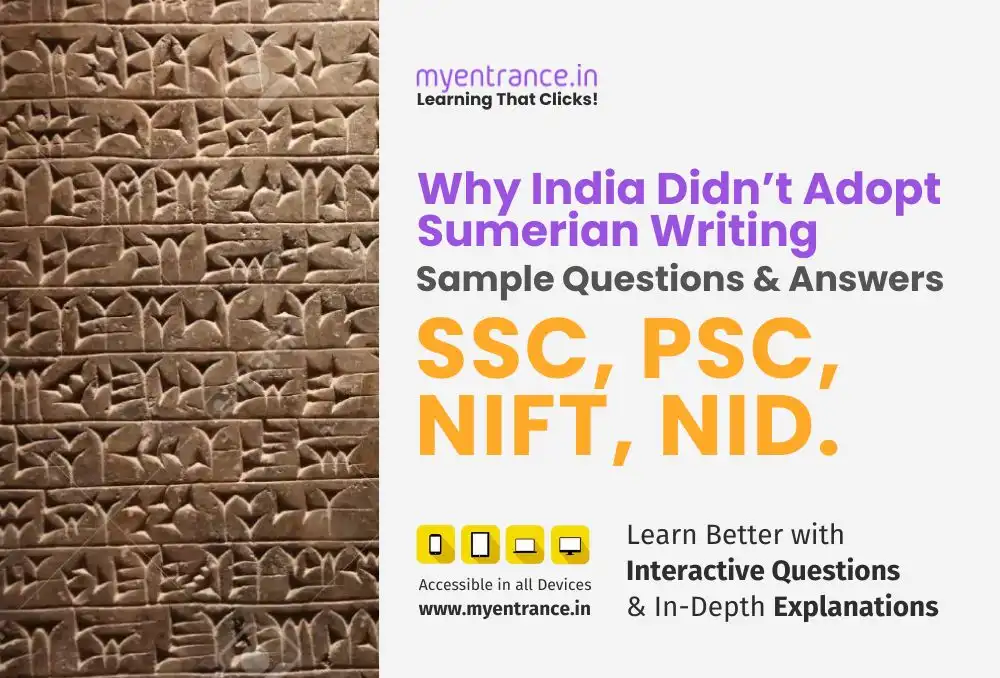Select Language
Harappan Script vs. Cuneiform: Why India Didn’t Adopt Sumerian Writing: Sample Q&A
Understanding script evolution (logographic → syllabic → alphabetic → abugida) is key for Art & Culture. Covers Harappan seals, Ashokan edicts, and linguistic diversity – frequently tested in Prelims/Mains.
1. Global Script Evolution: A Timeline
3300 BC – Sumerian Cuneiform
Script Type: Logographic (emoji-like)
Direction: Left → Right
Key Innovation: Wedge marks on clay tablets
3200 BC – Egyptian Hieroglyphs
Script Type: Logographic
Direction: Top → Bottom / Bidirectional
Key Innovation: Sacred symbols
1200 BC – Phoenician
Script Type: Abjad (consonants only)
Direction: Right → Left
Key Innovation: First alphabet precursor
800 BC – Greek
Script Type: Alphabet (vowels + consonants)
Direction: Left → Right
Key Innovation: Invented vowels
500 BC – Brahmi (India)
Script Type: Abugida
Direction: Left → Right
Key Innovation: Circular vowel attachment
2. India’s Script Mysteries
Harappan Enigma (2500 BC)
Type: Likely logographic (debated)
Direction: Right → Left on seals; Boustrophedon (“ox-plough” alternating pattern) on impressions.
Trade with Sumerians: Adopted goods but not cuneiform – suggests strong indigenous script culture.
Brahmi’s Uniqueness (500 BC)
Abugida System: Vowels attach to consonants in circular positions (above, below, before, after).
Example: क् + ि = कि (vowel “i” attached left)
Historical Evidence:
Ashokan Edicts (250 BC): Oldest deciphered inscriptions.
Lalitavistara Sutra (300 AD): Lists Brahmi as Buddha’s first learned script.
Mythological Roots:
Hinduism: Named after Brahma (creator god).
Jainism: Digambar tradition credits 1st Tirthankara Rishabhadeva teaching daughter Brahmi (Adi Purana, 900 AD).
3. Revolutionary Innovations
Phoenicians (1200 BC): Invented abjad (consonant-only writing) → led to Hebrew, Arabic, Persian (all right → left).
Greeks (800 BC): Added vowels → created true alphabet. Spread to India post-Alexander’s invasion (326 BC).
Cuneiform Shift (2800 BC): Logographic → Syllabary (sound units) to expand vocabulary beyond pictures.
4. Linguistic Diversity Explained
Logographic
Key Feature: Symbols represent words or ideas (like emojis)
Examples: Chinese, Hieroglyphs
Abjad
Key Feature: Only consonants are written
Examples: Arabic, Phoenician
Alphabet
Key Feature: Vowels and consonants are written separately
Examples: Greek, English
Abugida
Key Feature: Vowels are attached to consonants
Examples: Brahmi, Devanagari
Vowel-Consonant Ratios:
English: 5 vowels, 21 consonants
Nagari: 14 vowels, 34 consonants
Post-Read Questions Answered
Q1. Why is Brahmi’s vowel arrangement unique?
A: Vowels attach circularly to consonants (above/below/before/after), creating syllable blocks – a hybrid abugida system.
Q2. Brahmi’s Hindu-Jain connections?
A:
Hinduism: Named after creator god Brahma.
Jainism: First Tirthankara Rishabhadeva taught script to daughter Brahmi (Digambar tradition).
Q3. Sumerian script type?
A: Cuneiform – started as logographic, evolved into syllabary by 2800 BC.
Q4. Why didn’t Harappans adopt cuneiform?
A: Likely had a mature indigenous logographic script (evidenced by seals).
Q5. Phoenician innovation?
A: Invented abjad (consonant-only writing) → foundation for Hebrew, Aramaic, Arabic.
Most Predicted Questions
Comprehensive study materials, Expert-guided tips & tricks, Mock tests and instant results.
Start your SSC, NIFT, NID, FDDI, PSC journey today with MyEntrance, your ultimate online coaching platform.








